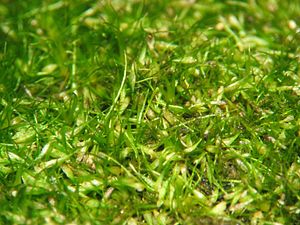Broken leaf moss
| Broken leaf moss | ||||||||||||
|---|---|---|---|---|---|---|---|---|---|---|---|---|

Broken leaf moss Dicranodontium denudatum |
||||||||||||
| Systematics | ||||||||||||
|
||||||||||||
| Scientific name | ||||||||||||
| Dicranodontium denudatum | ||||||||||||
| ( Brid. ) E. Britton |
The broken leaf moss ( Dicranodontium denudatum ) is a moss that rarely produces fruit. The formation of capsules has decreased significantly in recent years. In the dense lawn there are numerous fallen leaves, including breeding leaves, with which the moss can also reproduce vegetatively. Habitually it resembles Campylopus pyriformis . However, it can be distinguished by the fact that the lower lamina cells gradually merge into the upper ones and the peristome teeth are split up to the base.
Occurrence
The lime-avoiding moss prefers rotten wood, raw humus, peat soils, rare earth or overground rock in humid, shady bog and swamp forests. Typical accompanying mosses are Tetraphis pellucida , Lepidozia reptans and the common fork-tooth moss ( Dicranum scoparium ). It is less common in the lowlands than in the mountain regions.
Identifying features
The broken leaf moss grows up to 5 cm in size and grows in very dense, green to yellowish-green, very shiny lawns. The reddish-brown stalk has a clearly recognizable rhizoid felt. The protruding, sickle-shaped one-sided leaves are elongated tubular to awl-shaped. They are mostly toothed in the upper half. The broad leaf vein takes up about 1/3 of the leaf base. The leaf wing cells are inflated, thick and whitish hyaline.
photos
literature
- Martin Nebel, Georg Philippi (ed.): The mosses of Baden-Württemberg. Volume 1: General part, special part (Bryophytina I, Andreaeales to Funariales). Ulmer, Stuttgart 2000, ISBN 3-8001-3527-2 .
- Jan-Peter Frahm , Wolfgang Frey : Moosflora (= UTB . 1250). 4th, revised and expanded edition. Ulmer, Stuttgart 2004, ISBN 3-8252-1250-5 .

